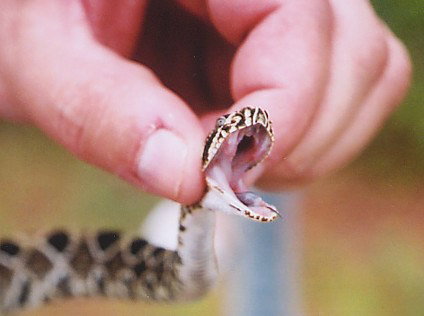

|
Eastern Diamondback Rattlesnake Crotalus adamanteus St. Joseph's Peninsula, Florida. September 2002. A closeup of the snake's head. The fangs are lying folded back along the roof of the mouth; they are hollow, and hinged to extend when striking. The tongue can clearly be seen, and behind it lies the glottis (bluish-coloured), which is a tube that extends when swallowing large prey to allow the snake to breathe. Just in front of the eyes lie the "pits" that give pit Vipers their name. They are infra-red detecting organs which sense the heat radiating from warm-blooded creatures, giving the snake the ability to "see" its prey even in total darkness.Using the pits, a rattlesnake can even see the warmth from recent footprints of a rodent. |